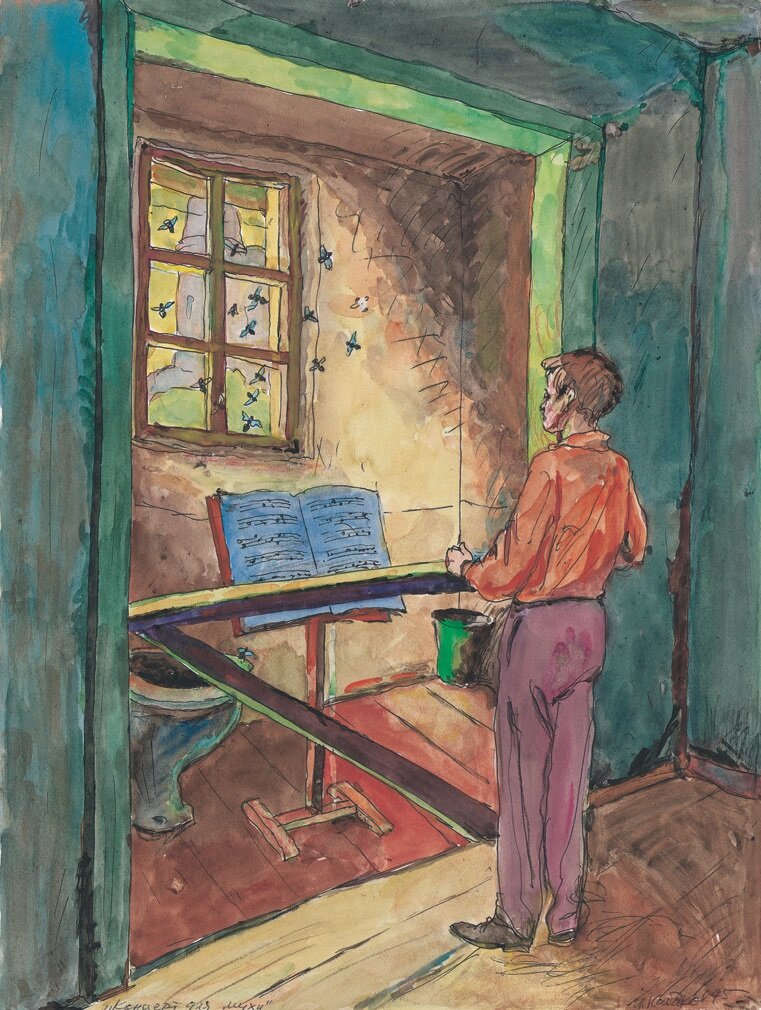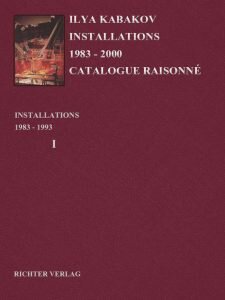Concert for a Fly
YEAR: 1993
CATALOGUE NUMBER: 71
PROVENANCE
The artist
Collection Château d’Oiron, Oiron
NOTES
Permanent installation in the Château d’Oiron, Oiron
Musical arrangement by Vladimir Tarasov
EXHIBITIONS
London, England, United Kingdom, Galerie Thaddaeus Ropac – London Ely House
Concert for a Fly (Chamber Music), 15 Sep 2017 — 11 Nov 2017. Musical Arrangement by Joseph Morag
Paris, France, Galerie Thaddaeus Ropac
Ilya and Emilia Kabakov: Musique de Chambre, 2 Dec 2017 – 24 Feb 2018. Musical Arrangement by Joseph Morag
Venice, Fondazione Querini Stampalia
Ilya and Emilia Kabakov. Between Heaven and Earth, 13 Apr 2024 — 14 Jul 2024
DESCRIPTION
In a small space (3.5 x 4.5 meters) against the background of a window are hung 10-12 flies (plastic) in such a way that it appears they are swarming, flying around in front of the window. A music stand is in the center of the room holding a musical score: ‘A Fly Symphony.’ Inside resounds music written by Vladimir Tarasov especially for this installation. The music consists of three parts in which a recording of the real sound of flies is used. For the viewer – he is also the listener – who is standing on the other side of the barrier (it is impossible actually to enter into the installation), what appears to be ordinary buzzing of flies is transformed into a precisely and strictly harmonized three-part concert as soon as he begins to really pay attention to the music.
The location for this installation was not selected accidentally, and of course (as always), the ‘circumstances of place’ play the main role for the atmosphere and functioning of the installation. In the Loire, far away from Paris, there is a wonderful, but already old, decrepit castle from the 16th Century, Château D’Oiron, where naturally, despite the restoration efforts, a spirit of neglect and sad melancholy reigns in many from its corners and rooms. One such corner is a small room, a toilet, with a narrow window looking out on the nearby tower of the castle with a view of the distant field and the forest beyond the hill. It is difficult to imagine a more depressing and yet at the same time cheerily sentimental place: an old but simple dust-covered window. Inside on the floor is plaster from the crumbling walls and ceiling, and the toilet is also rather old, virtually an antique.
The castle-museum is visited by tourists mostly in the summer, and that’s when the installation works most effectively: a multitude of real flies appears on the window (it is the sunny side of the castle) and they form a unified whole with the hanging artificial flies and their actual buzzing combines with the ‘fly symphony.’
CONCEPT OF THE INSTALLATION
It was proposed by Jean-Hubert Martin to create an installation in the Château D’Oiron, where he was the director. We arrived to take a look at the place, and we were, as is said in such cases, entirely enchanted by the ancient French castle that belongs to the chain of ‘castles of the Loire,’ by the magical, romantic gates and courtyards. Inside the castle, everything was mysterious and intriguing – wide, empty staircases and corridors, suites and labyrinths of rooms … Through the high windows, we could see the distant, sunny landscape, the meadow surrounding the castle and the forest beyond. Finally, walking down the corridor, I bumped into a small corner room which by virtue of its size and location could only have been used as a ‘service room’ – it was a toilet, with an oddly shaped commode standing in the corner, with the floor made of old tiles. But my attention was focused not so much on the toilet, which without a doubt was the center of the entire room, but on its secondary center that attracts one immediately, as soon as you find yourself in the small doorway – the window in the thick wooden frame without any windowsill at all. It attracted me not only because of its marvelous view and the edge of the fortress wall, but also because of the multitude of flies that were flying around and warming themselves on the window in the rays of the warm sun. The toilet and the flies – this combination was entirely sufficient for my installation. (At that time I was fervently ‘enthralled’ by flies and was always searching for a place to insert them.)
The idea immediately emerged to create a Concert for a Fly.
I decided to place notes near the door that would record this concert, and I suggested to Vladimir Tarasov that he compose the music. He took a very long time waiting for the right moment, and then he wrote something like a dramatic symphony in three parts. For the recording, he used the sound of the buzzing of a real fly that he had put in a jar for that purpose. He made a recording using a special microphone, and then he parceled the sound using a synthesizer. What resulted was very dramatic, serious music that one could listen to quite pensively, resting one’s elbows on the barrier blocking the door that prevented anyone from entering and permitted visitors only to listen to this ‘musical’ installation from outside.1 Flies flew around, the music resounded, the notes spoke of the musical competency and seriousness of the whole concept … Nonetheless, one very important problem arose – the installation with flies could ‘work,’ so to speak, only during the summer season while it was still warm, but in the winter, obviously, flies usually hibernate and it would have been impossible to awaken them for the sake of some artistic goals.
So, it was necessary to add to the living flies artificial ones, so that they could ‘work’ and ‘fly’ inside the room while the ‘real’ ones were sleeping.
During evening hours, the room was illuminated by a single light-bulb hanging from the ceiling.
Images
Literature






